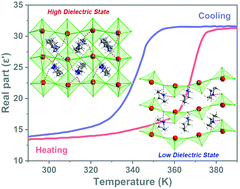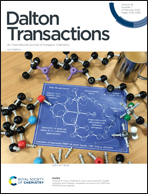Dielectric phase transition of an A2BX4-type perovskite with a pentahedral to octahedral transformation†
Abstract
Organic–inorganic hybrid compounds that undergo reversible dielectric phase transitions are a very attractive class of smart materials due to their wide applications in data storage, data communication and signal sensing. Here, a piperidine ring, C5H11N, was introduced into the inorganic lead halide perovskite scaffold to obtain three hybrid perovskite compounds, [C5H12N]2PbCl4 (1), [C5H12N]2PbBr4 (2), and [C5H12N]PbI3 (3). When compound 2 and compound 3 feature static two-dimensional (2D) and one-dimensional (1D) perovskite structures, respectively, it is striking that compound 1 shows a reversible pentahedral to octahedral transformation. It undergoes an above-room-temperature dielectric phase transition at Tc ≅ 352 K, wherein the high dielectric constant is more than twice the low dielectric constant. Structural analysis shows that 1 undergoes a phase transition from the space group Pnma at the low temperature phase (LTP) to C2/c at the high temperature phase (HTP). The phase transition originates from the order–disorder conversion of piperidinium cations. It is interesting to note that, the Pb2+ cations in the inorganic moieties change from five-coordinate at the LTP to six-coordinate at the HTP. The discovery of dielectric phase transition hybrid organic–inorganic lead halide perovskite materials further enhances the potential applications of high temperature responsive dielectric switchable materials.



 Please wait while we load your content...
Please wait while we load your content...